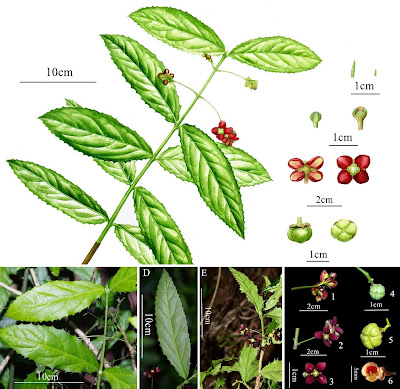 |
| Euonymus chengduanus J. Hu & H. He, in Hu, Huang, Luo, Liu, He et Liu, 2025. |
ABSTRACT
The establishment of native species-dominated forest parks and investment into vegetation surveys and taxonomic research has not only enabled the discovery of relictnative species affected by urban expansion but also facilitated targeted conservation efforts. During investigations on plant diversity and vegetation status in Longquan Mountain Urban Forest Park in eastern Chengdu Metropolis, West China, an unidentified species of Euonymus (Celastraceae) was encountered. It resembles both E. chloranthoides and E. aquifolium in vegetative appearance, but it has exclusively 4-merous flowers. A phylogenetic analysis incorporating 51 taxa of Euonymus and Glyptopetalum supported its recognition as a new species, positioned phylogenetically sister to a clade containing Glyptopetalum species, and close to E. chloranthoides and E. aquifolium. To acknowledge the expanded Chengdu urbanization and the recently planned mountain urban forest park, it is described as Euonymus chengduanus, and its diagnostic morphological characters are compared with E. aquifolium, E. chloranthoides, and Glyptopetalum ilicifolium. This discovery implies that even in intensively anthropogenic-impacted areas adjacent to large cities, undocumented plant diversity may still exist. Consequently, this new species is tentatively assessed as Critically Endangered (CR) to emphasize both the urgency of its protection and to raise public awareness concerning biodiversity in degraded ecosystems.
Keywords: Celastraceae, degraded ecosystem, Euonymus, Glyptopetalum, new species, urban
Euonymus chengduanus J. Hu & H. He, sp. nov.
Diagnosis: This new species appears closely related to Euonymus chloranthoides in vegetative organs, inflorescence, and adjacent distribution, but it can be easily differentiated from the latter by its 4-merous flowers, mostly light green floral disc, unlobed fruits, and a secondary vein framework showing festooned semicraspedodromous patterns. It also shares a certain extent of similarity to both E. aquifolium and Glyptopetalum ilicifolium, and these four species can be distinguished from the morphological characters of leaf, flower, and fruit (Table 1 and Figure 2).
Etymology: The species epithet refers to the megapolis of Chengdu, and the Latin adjective ending-anus indicating location. Chengdu is one the largest urban areas in western China with Thousands of years of history. Mountainous regions on the West of Chengdu hold huge biodiversity, where E. H. Wilson (referring to Sargent 1911–1913) had collected quite a lot living plants and specimens, and Wilson (1929) himself accredited Chengdu as “the Garden of West China”. However, no plant has been credited to the city name of Chengdu. Urbanization in recent decades has enlarged the city of Chengdu around all the way outside, and extending eastwards across Longquan Mountain to Jianyang City. This is the first plant species named after Chengdu, and a Chinese name “成都卫矛(Chéng dū wèi máo)” is here suggested.
Jun Hu, Xin Huang, Yao Luo, Qiurong Liu, Hai He and Qing Liu. 2025. Euonymus chengduanus (Celastraceae), A New Species unexpectedly discovered in an Urban Forest Park in the Megacity of Chengdu, West China. Ecology and Evolution. DOI: doi.org/10.1002/ece3.71234 [10 April 2025]

